Spectral Analysis and Mutual Information Estimation of Left and Right Intracardiac Electrograms during Ventricular Fibrillation
Abstract
1. Introduction
2. Related Work
3. Methods
3.1. Intracardiac Electrogram (EGM) Signals and Ventricular Fibrillation (VF)
3.2. VF Signals Detection and Patient Database
3.3. Spectral Measurements
3.4. Information Theory Measurements
4. Results
4.1. Spectral Measurements on Patients
4.2. Information Theory Measurements on Simulations
4.3. Information Theory Measurements on Cardiac Signals
5. Discussion
Author Contributions
Funding
Acknowledgments
Conflicts of Interest
References
- Cardiovascular Diseases (CVDs); Technical Report; World Health Organization (WHO): Geneva, Switzerland, 2017.
- Defunciones Según Causa de Muerte 2017; Technical Report; Instituto Nacional de Estadística (INE): Madrid, Spain, 2017.
- Alonso-Atienza, F.; Rojo-Álvarez, J.L.; Rosado-Muñoz, A.; Vinagre, J.J.; García-Alberola, A.; Camps-Valls, G. Feature selection using support vector machines and bootstrap methods for ventricular fibrillation detection. Expert Syst. Appl. 2012, 39, 1956–1967. [Google Scholar] [CrossRef]
- Moe, G.K.; Rheinboldt, W.C.; Abildskov, J. A computer model of atrial fibrillation. Am. Heart J. 1964, 67, 200–220. [Google Scholar] [CrossRef]
- Gelzer, A.R.; Koller, M.L.; Otani, N.F.; Fox, J.J.; Enyeart, M.W.; Hooker, G.J.; Riccio, M.L.; Bartoli, C.R.; Gilmour, R.F., Jr. Dynamic mechanism for initiation of ventricular fibrillation in vivo. Circulation 2008, 118, 1123. [Google Scholar] [CrossRef] [PubMed]
- Winfree, A. Electrical turbulence in three-dimensional heart muscle. Science 1994, 266, 1003–1006. [Google Scholar] [CrossRef]
- Jalife, J. Time, space and frequency in ventricular fibrillation. Rev. Española Cardiol. (English Edition) 2006, 59, 859–861. [Google Scholar] [CrossRef]
- Pandit, S.V.; Jalife, J. Rotors and the dynamics of cardiac fibrillation. Circ. Res. 2013, 112, 849–862. [Google Scholar] [CrossRef] [PubMed]
- Pachón, M.I.; Jalife, J. New concepts on the mechanisms of ventricular fibrillation. Rev. EspañOla Cardiol. 2001, 54, 373–382. [Google Scholar]
- Jalife, J. Rotors and spiral waves in atrial fibrillation. J. Cardiovasc. Electrophysiol. 2003, 14, 776–780. [Google Scholar] [CrossRef] [PubMed]
- Sánchez-Muñoz, J.J.; Rojo-Álvarez, J.L.; García-Alberola, A.; Everss, E.; Alonso-Atienza, F.; Ortiz, M.; Martínez-Sánchez, J.; Ramos-López, J.; Valdés-Chavarri, M. Spectral analysis of intracardiac electrograms during induced and spontaneous ventricular fibrillation in humans. Europace 2009, 11, 328–331. [Google Scholar] [CrossRef] [PubMed]
- Faust, O.; Bairy, M.G. Nonlinear analysis of physiological signals: A review. J. Mech. Med. Biol. 2012, 12, 1240015. [Google Scholar] [CrossRef]
- Hajeb-Mohammadalipour, S.; Ahmadi, M.; Shahghadami, R.; Chon, K. Automated method for discrimination of arrhythmias using time, frequency, and nonlinear features of electrocardiogram gignals. Sensors 2018, 18, 2090. [Google Scholar] [CrossRef] [PubMed]
- Clifford Gari, D.; Azuaje Francisco, M.P.E. Review of Advanced Methods and Tools for ECG Data Analysis. Biomed. Eng. Online 2007, 6, 18. [Google Scholar]
- Corino, V.D.; Sassi, R.; Mainardi, L.T.; Cerutti, S. Signal processing methods for information enhancement in atrial fibrillation: Spectral analysis and non-linear parameters. Biomed. Signal Process. Control. 2006, 1, 271–281. [Google Scholar] [CrossRef]
- Antoniadis, A.P.; Sieniewicz, B.; Gould, J.; Porter, B.; Webb, J.; Claridge, S.; Behar, J.M.; Rinaldi, C.A. Updates in cardiac resynchronization therapy for chronic heart failure: Review of multisite pacing. Curr. Heart Fail. Rep. 2017, 14, 376–383. [Google Scholar] [CrossRef]
- Stavrakis, S.; Dyer, J.W.; Koomson, E.; Scherlag, B.J.; Bhardwaj, B.; Lazzara, R.; Po, S.S. Spectral analysis of baseline electrocardiogram during atrial fibrillation predicts response to antiarrhythmic drug therapy in patients with persistent atrial fibrillation. J. Cardiovasc. Electrophysiol. 2016, 27, 1312–1318. [Google Scholar] [CrossRef]
- Petrutiu, S.; Ng, J.; Nijm, G.M.; Al-Angari, H.; Swiryn, S.; Sahakian, A.V. Atrial fibrillation and waveform characterization. IEEE Eng. Med. Biol. Mag. 2006, 25, 24–30. [Google Scholar] [CrossRef] [PubMed]
- Chen, P.; Chang, M.; Tu, K.; Yu, S.; Liu, C. Study of using Fourier transform to capture the ECG signals between awakeness and dozing. In Proceedings of the 2016 International Symposium on Computer, Consumer and Control, Xi’an, China, 4–6 July 2016; pp. 1055–1058. [Google Scholar]
- Jeon, E.; Jung, B.K.; Nam, Y.; Lee, H. Classification of premature ventricular contraction using error back-propagation. KSII Trans. Internet Inf. Syst. 2018, 12, 988–1001. [Google Scholar]
- Gupta, V.; Mittal, M. R-Peak detection in ECG signal using Yule–Walker and principal component analysis. IETE J. Res. 2019, 19, 1–14. [Google Scholar] [CrossRef]
- Rodríguez-Bermúdez, G.; García-Laencina, P.J. Analysis of EEG signals using nonlinear dynamics and chaos: A review. Appl. Math. Inf. Sci. 2015, 9, 2309. [Google Scholar]
- De Godoy, M.F. Nonlinear analysis of heart rate variability: A comprehensive review. J. Cardiol. Ther. 2016, 3, 528–533. [Google Scholar] [CrossRef]
- Shi, M.; Zhan, C.; He, H.; Jin, Y.; Wu, R.; Sun, Y.; Shen, B. Renyi distribution entropy analysis of short-term heart rate variability signals and its application in coronary artery disease detection. Front. Physiol. 2019, 10, 1–14. [Google Scholar] [CrossRef] [PubMed]
- Carlisle, E.J.; Allen, J.D.; Kernohan, W.G.; Leahey, W.; Adgey, A.J. Pharmacological analysis of established ventricular fibrillation. Br. J. Pharmacol. 1990, 100, 530–534. [Google Scholar] [CrossRef] [PubMed]
- Chorro, F.J.; Sánchez-Muñoz, J.J.; Sanchis, J.; Cortina, J.; Bataller, M.; Guerrero, J.; Espí, J.; Ruipérez, J.A.; López-Merino, V. Modifications in the evolution of the dominant frequency in ventricular fibrillation induced by amiodarone, diltiazem, and flecainide: An experimental study. J. Electrocardiol. 1996, 29, 319–326. [Google Scholar] [CrossRef]
- Strohmenger, H.U.; Lindner, K.H.; Keller, A.; Lindner, I.M.; Pfenninger, E.G. Spectral analysis of ventricular fibrillation and closed-chest cardiopulmonary resuscitation. Resuscitation 1996, 33, 155–161. [Google Scholar] [CrossRef]
- Sánchez-Muñoz, J.J.; Rojo-Álvarez, J.L.; García-Alberol, A.; Everss, E.; Requena-Carrión, J.; Ortiz, M.; Alonso-Atienza, F.; Valdés-Chavarri, M. Effects of the location of myocardial infarction on the spectral characteristics of ventricular fibrillation. Pacing Clin. Electrophysiol. 2008, 31, 660–665. [Google Scholar] [CrossRef]
- Altuve, M.A. Variabilidad de la frecuencia cardíaca: Técnicas temporales, frecuenciales y no lineales. In Proceedings of the VI Congreso Venezolano de Bioingeniería, Cabimas, Venezuela, 4 October 2017; pp. 23–26. [Google Scholar]
- Zheng, L.; Pan, W.; Li, Y.; Luo, D.; Wang, Q.; Liu, G. Use of mutual information and transfer entropy to assess interaction between parasympathetic and sympathetic activities of nervous system from HRV. Entropy 2017, 19, 489. [Google Scholar] [CrossRef]
- Hoyer, D.; Leder, U.; Hoyer, H.; Pompe, B.; Sommer, M.; Zwiener, U. Mutual information and phase dependencies: Measures of reduced nonlinear cardiorespiratory interactions after myocardial infarction. Med. Eengineering Phys. 2002, 24, 33–43. [Google Scholar] [CrossRef]
- Bai, W.; Shi, W.; Wang, H.; Peters, N.S.; Rueckert, D. Multiatlas based segmentation with local label fusion for right ventricle MR images. Image 2012, 6, 1–8. [Google Scholar]
- Rogers, J.M.; Huang, J.; Pedoto, R.W.; Walker, R.G.; Smith, W.M.; Ideker, R.E. Fibrillation is more complex in the left ventricle than in the right ventricle. J. Cardiovasc. Electrophysiol. 2000, 11, 1364–1371. [Google Scholar] [CrossRef]
- Valderrábano, M.; Lee, M.H.; Ohara, T.; Lai, A.C.; Fishbein, M.C.; Lin, S.F.; Karagueuzian, H.S.; Chen, P.S. Dynamics of intramural and transmural reentry during ventricular fibrillation in isolated swine ventricles. Circ. Res. 2001, 88, 839–848. [Google Scholar] [CrossRef]
- Steffen, M.M.; Osborn, J.S.; Cutler, M.J. Cardiac implantable electronic device therapy: Permanent pacemakers, implantable cardioverter defibrillators, and cardiac resynchronization devices. Med. Clin. 2019, 103, 931–943. [Google Scholar]
- Palastanga, N.; Field, D.; Soames, R. Anatomía y Movimiento Humano. Estructura y Funcionamiento; Editorial Paidotribo: Barcelona, Spain, 2007. [Google Scholar]
- Fleming, J.S. Interpreting the Electrocardiogram; Springer Science & Business Media: London, UK, 2012. [Google Scholar]
- Lal, R.; Chapman, P.D.; Naccarelli, G.V.; Schechtman, K.B.; Rinkenberger, R.L.; Troup, P.J.; Kim, S.S.; Dougherty, A.H.; Ruffy, R. Flecainide in the treatment of nonsustained ventricular tachycardia. Ann. Intern. Med. 1986, 105, 493–498. [Google Scholar] [CrossRef]
- Salerno, D.M.; Gillingham, K.J.; Berry, D.A.; Hodges, M. A comparison of antiarrhythmic drugs for the suppression of ventricular ectopic depolarizations: A meta-analysis. Am. Heart J. 1990, 120, 340–353. [Google Scholar] [CrossRef]
- Bacaner, M.B. Treatment of ventricular fibrillation and other acute arrhythmias with bretylium tosylate. Am. J. Cardiol. 1968, 21, 530–543. [Google Scholar] [CrossRef]
- Ng, G.A. Treating patients with ventricular ectopic beats. Heart 2006, 92, 1707–1712. [Google Scholar] [CrossRef] [PubMed]
- Barquero-Pérez, O.; Rojo-Álvarez, J.L.; Caamano, A.J.; Goya-Esteban, R.; Everss, E.; Alonso-Atienza, F.; Sánchez-Muñoz, J.J.; García-Alberola, A. Fundamental frequency and regularity of cardiac electrograms with Fourier organization analysis. IEEE Trans. Biomed. Eng. 2010, 57, 2168–2177. [Google Scholar] [CrossRef] [PubMed]
- Ashikaga, H.; Aguilar-Rodríguez, J.; Gorsky, S.; Lusczek, E.; Marquitti, F.M.D.; Thompson, B.; Wu, D.; Garland, J. Modelling the heart as a communication system. J. R. Soc. Interface 2015, 12, 20141201. [Google Scholar] [CrossRef]
- McGillivray, M.F.; Cheng, W.; Peters, N.S.; Christensen, K. Machine learning methods for locating re-entrant drivers from electrograms in a model of atrial fibrillation. R. Soc. Open Sci. 2018, 5, 172434. [Google Scholar] [CrossRef]
- Moreno, J.; Warren, M.; Jalife, J. Ionic currents and ventricular fibrillation dynamics. Rev. Española Cardiol. (English Edition) 2004, 57, 69–79. [Google Scholar] [CrossRef]
- Jalife, J. Rotors and fibrillation. Arch. Cardiol. México 2004, 74, 289–292. [Google Scholar]
- Scientific, B. How CRTs Work. Available online: http://www.bostonscientific.com (accessed on 22 January 2020).
- Brignole, M.; Auricchio, A.; Barón-Esquivias, G.; Bordachar, P.; Boriani, G.; Breithardt, O.A.; Cleland, J.; Deharo, J.C.; Delgado, V.; Elliott, P.M.; et al. Guía de práctica clínica de la ESC 2013 sobre estimulación cardiaca y terapia de resincronización cardiaca. Rev. Española Cardiol. 2014, 67, 58. [Google Scholar]
- Rogers, D.P.; Lambiase, P.D.; Lowe, M.D.; Chow, A.W. A randomized double-blind crossover trial of triventricular versus biventricular pacing in heart failure. Eur. J. Heart Fail. 2012, 14, 495–505. [Google Scholar] [CrossRef]
- Sanromán Junquera, M. Advanced Intracardiac Electrogram Analysis for Arrhythmia Ablation Support. Ph.D. Thesis, Universidad Rey Juan Carlos, Madrid, Spain, 2014. [Google Scholar]
- Picone, J.W. Signal modeling techniques in speech recognition. In International Conference on Acoustics, Speech, and Signal Processing; IEEE: Piscataway, NJ, USA, 1993; pp. 1215–1247. [Google Scholar]
- Eftestøl, T.; Sunde, K.; Ole Aase, S.; Husøy, J.H.; Steen, P.A. Predicting outcome of defibrillation by spectral characterization and nonparametric classification of ventricular fibrillation in patients with out-of-hospital cardiac arrest. Circulation 2000, 102, 1523–1529. [Google Scholar] [CrossRef]
- Sanders, P.; Berenfeld, O.; Hocini, M.; Jaïs, P.; Vaidyanathan, R.; Hsu, L.F.; Garrigue, S.; Takahashi, Y.; Rotter, M.; Sacher, F.; et al. Spectral analysis identifies sites of high-frequency activity maintaining atrial fibrillation in humans. Circulation 2005, 112, 789–797. [Google Scholar] [CrossRef]
- Samie, F.H.; Berenfeld, O.; Anumonwo, J.; Mironov, S.F.; Udassi, S.; Beaumont, J.; Taffet, S.; Pertsov, A.M.; Jalife, J. Rectification of the background potassium current: A determinant of rotor dynamics in ventricular fibrillation. Circ. Res. 2001, 89, 1216–1223. [Google Scholar] [CrossRef]
- Moraes, J.; Blechner, M.; Vilani, F.; Costa, E. Ventricular fibrillation detection using a leakage/complexity measure method. In Proceedings of the Computers in Cardiology, Memphis, TN, USA, 22–25 September 2002; IEEE: Piscataway, NJ, USA, 2002; pp. 213–216. [Google Scholar]
- Rojo-Álvarez, J.L.; Martínez-Ramón, M.; Figueiras-Vidal, A.R.; García-Armada, A.; Artés-Rodríguez, A. A robust support vector algorithm for nonparametric spectral analysis. IEEE Signal Process. Lett. 2003, 10, 320–323. [Google Scholar] [CrossRef]
- Smelser, N.J.; Baltes, P.B. International Encyclopedia of the Social & Behavioral Sciences; Elsevier: Amsterdam, The Netherlands, 2001; Volume 11. [Google Scholar]
- Gray, R.M. Entropy and Information Theory; Springer Science & Business Media: Stanford, CA, USA, 2011. [Google Scholar]
- González-González, M.; Barquero-Pérez, O.; Soguero-Ruiz, C.; Sánchez-Muñoz, J.J.; Rojo-Álvarez, J.L.; García-Alberola, A. Nonlinear characteristics of ventricular fibrillation depend on myocardial infarction locations. In Proceedings of the Computing in Cardiology 2013, Zaragoza, Spain, 22–25 September 2013; IEEE: Piscataway, NJ, USA, 2013; pp. 619–622. [Google Scholar]
- Pak, H.N.; Kim, Y.H.; Lim, H.E.; Chou, C.C.; Miyauchi, Y.; Fang, Y.H.; Sun, K.; Hwang, C.; Chen, P.S. Role of the posterior papillary muscle and purkinje potentials in the mechanism of ventricular fibrillation in open chest dogs and Swine: Effects of catheter ablation. J. Cardiovasc. Electrophysiol. 2006, 17, 777–783. [Google Scholar] [CrossRef]
- Masse, S.; Downar, E.; Chauhan, V.; Sevaptsidis, E.; Nanthakumar, K. Ventricular fibrillation in myopathic human hearts: Mechanistic insights from in vivo global endocardial and epicardial mapping. Am. J. Physiol.-Heart Circ. Physiol. 2007, 292, H2589–H2597. [Google Scholar] [CrossRef] [PubMed]
- Caldwell, J.; Burton, F.L.; Smith, G.L.; Cobbe, S.M. Heterogeneity of ventricular fibrillation dominant frequency during global ischemia in isolated rabbit hearts. J. Cardiovasc. Electrophysiol. 2007, 18, 854–861. [Google Scholar] [CrossRef] [PubMed]
- Chorro, F.J.; Guerrero, J.; Cánoves, J.; Trapero, I.; Mainar, L.; Pelechano, F.; Blasco, E.; Such-Miquel, L.; Ferrero, Á.; Sanchis, J.; et al. Changes in the spectral characteristics of ventricular fibrillation in lesions produced by radiofrequency ablation. An experimental study. Rev. Española Cardiol. (English Edition) 2008, 61, 394–403. [Google Scholar] [CrossRef]
- Chorro, F.J.; Guerrero, J.; Trapero, I.; Such-Miquel, L.; Mainar, L.; Cánoves, J.; Blasco, E.; Ferrero, Á.; Sanchís, J.; Bodí, V.; et al. Time-frequency analysis of ventricular fibrillation. An experimental study. Rev. EspañOla Cardiol. (English Edition) 2006, 59, 869–878. [Google Scholar] [CrossRef]
- Chorro, F.J.; Guerrero, J.; Pelechano, F.; Trapero, I.; Mainar, L.; Cánoves, J.; Such-Miquel, L.; García-Alberola, A.; Ferrero, Á.; Sanchís, J.; et al. Influence of recording mode (unipolar or bipolar) on the spectral characteristics of epicardial recordings in ventricular fibrillation. an experimental study. Rev. Española Cardiol. (English Edition) 2007, 60, 1059–1069. [Google Scholar] [CrossRef]
- Torres, J.L.; Shah, B.K.; Greenberg, R.M.; Deger, F.T.; Gerstenfeld, E.P. A left ventricular epicardial to right ventricular endocardial dominant frequency gradient exists in human ventricular fibrillation. J. Interv. Card. Electrophysiol. 2010, 29, 11–16. [Google Scholar] [CrossRef]
- Sánchez-Muñoz, J.J.; Rojo-Álvarez, J.L.; García-Alberola, A.; Carrión, J.R.; Everss, E.; Ortiz, M.; Martínez-Sánchez, J.; Chávarri, M.V. Spectral analysis of sustained and non-sustained ventricular fibrillation in patients with an implantable cardioverter-defibrillator. Rev. EspañOla Cardiol. (English Edition) 2009, 62, 690–693. [Google Scholar] [CrossRef]
- Brown, C.G.; Griffith, R.F.; Van Ligten, P.; Hoekstra, J.; Nejman, G.; Mitchell, L.; Dzwonczyk, R. Median frequency: A new parameter for predicting defibrillation success rate. Ann. Emerg. Med. 1991, 20, 787–789. [Google Scholar] [CrossRef]
- Strohmenger, H.U.; Lindner, K.H.; Lurie, K.G.; Welz, A.; Georgieff, M. Frequency of ventricular fibrillation as a predictor of defibrillation success during cardiac surgery. Anesth. Analg. 1994, 79, 434–438. [Google Scholar] [CrossRef]

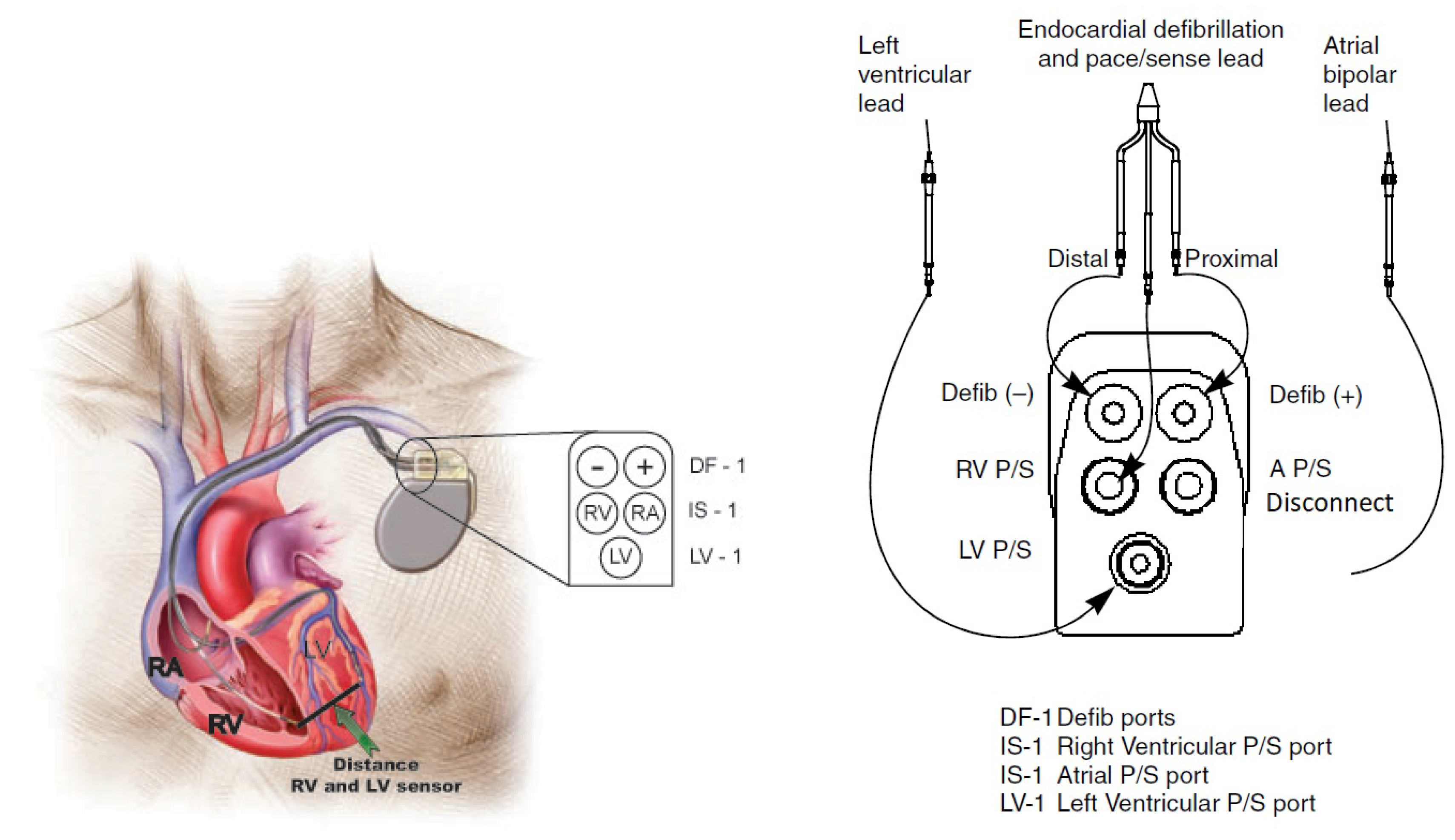

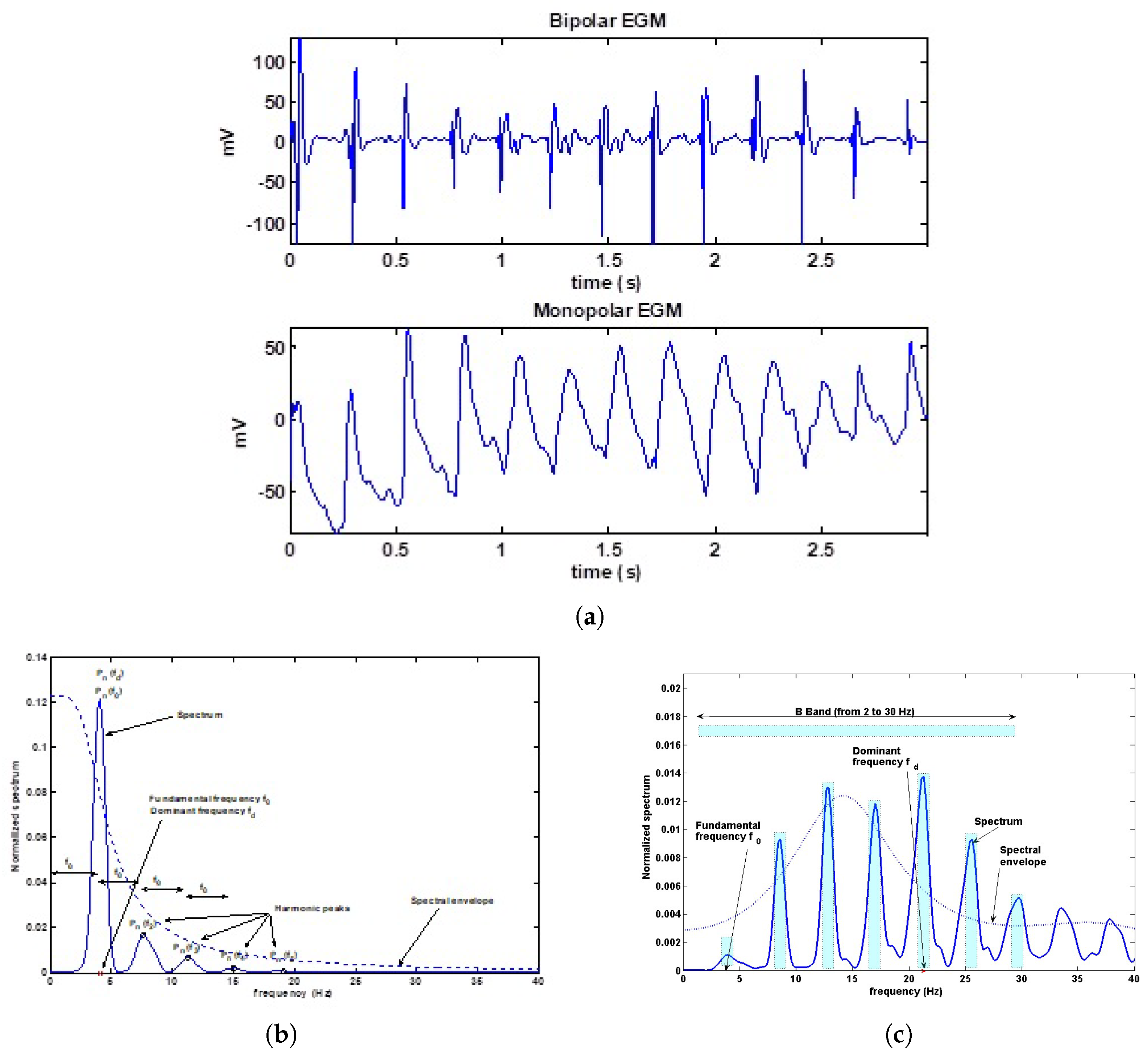
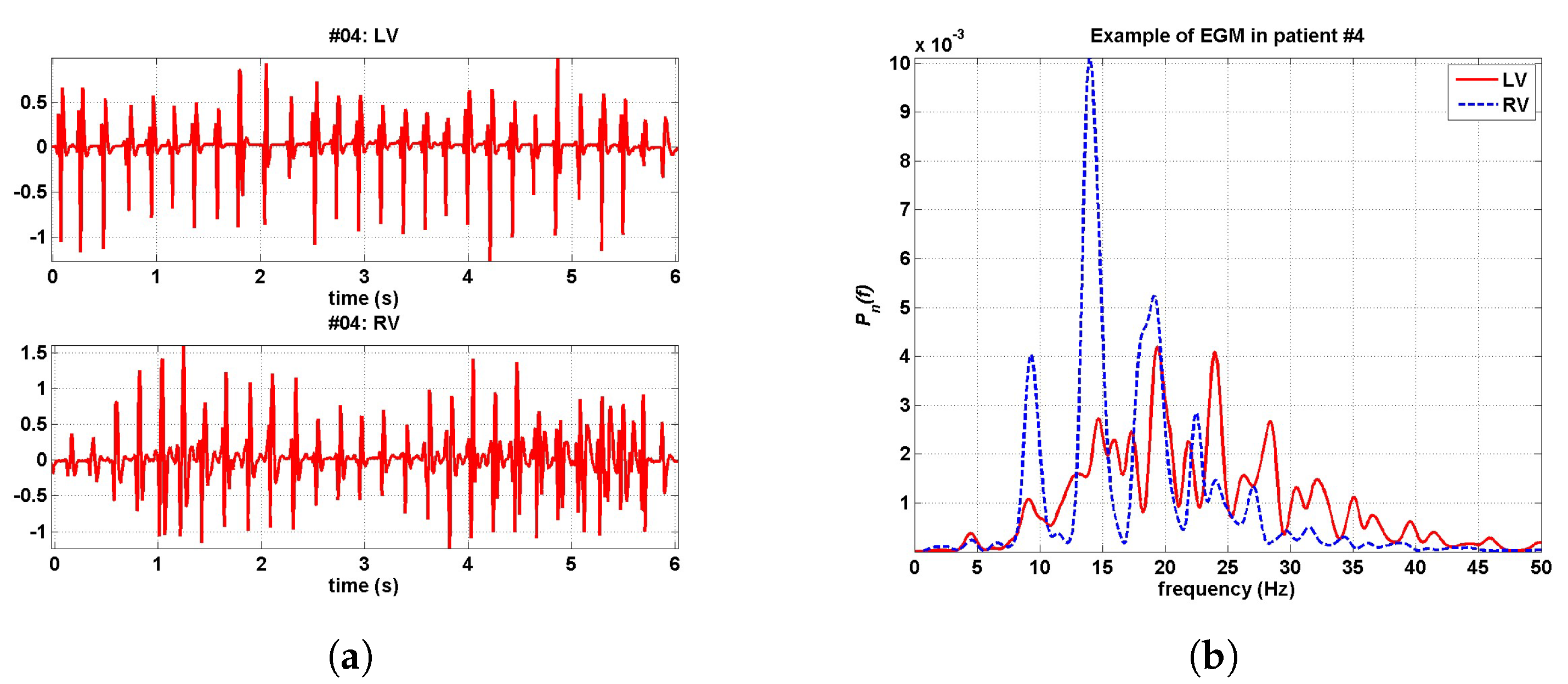
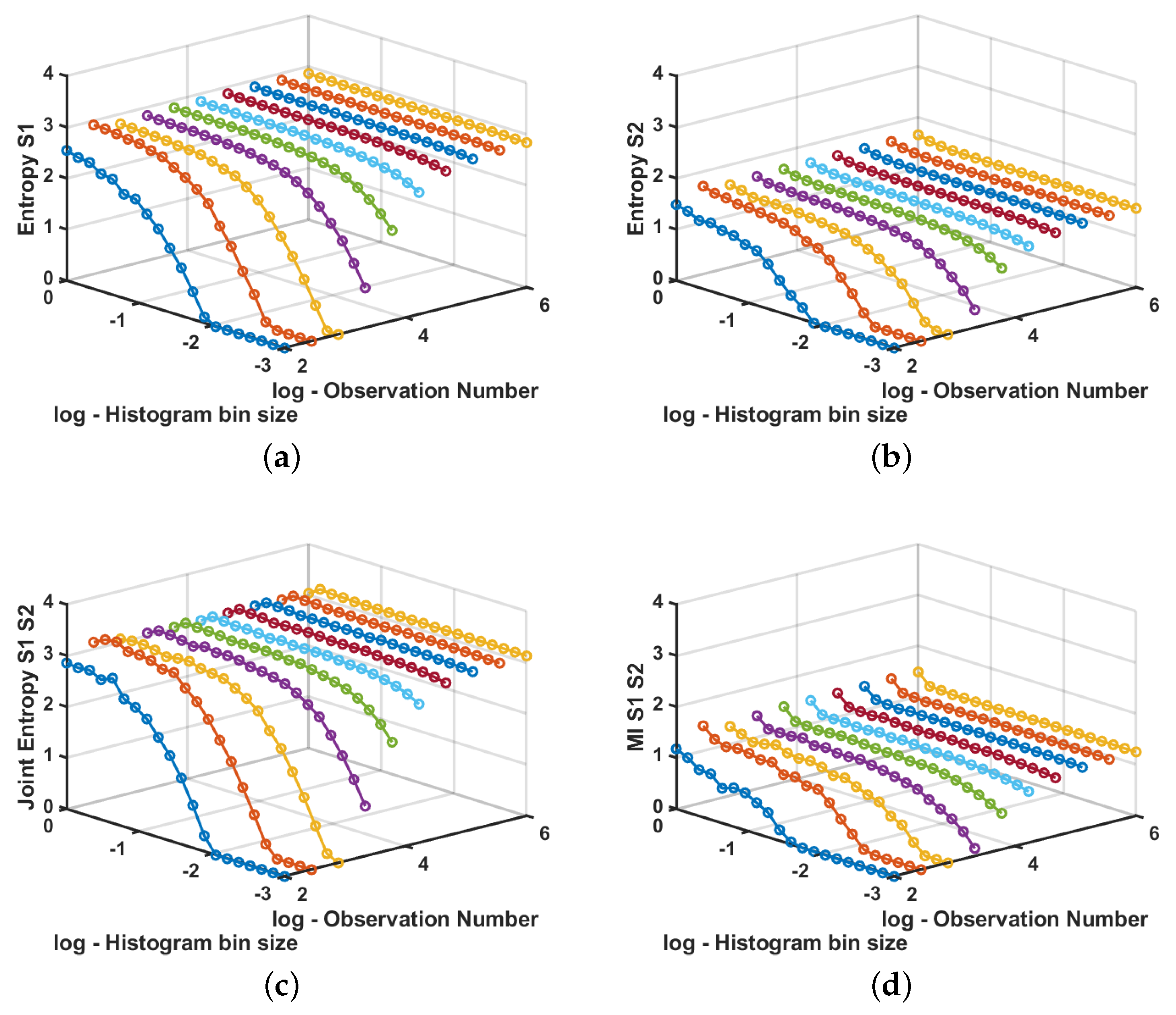
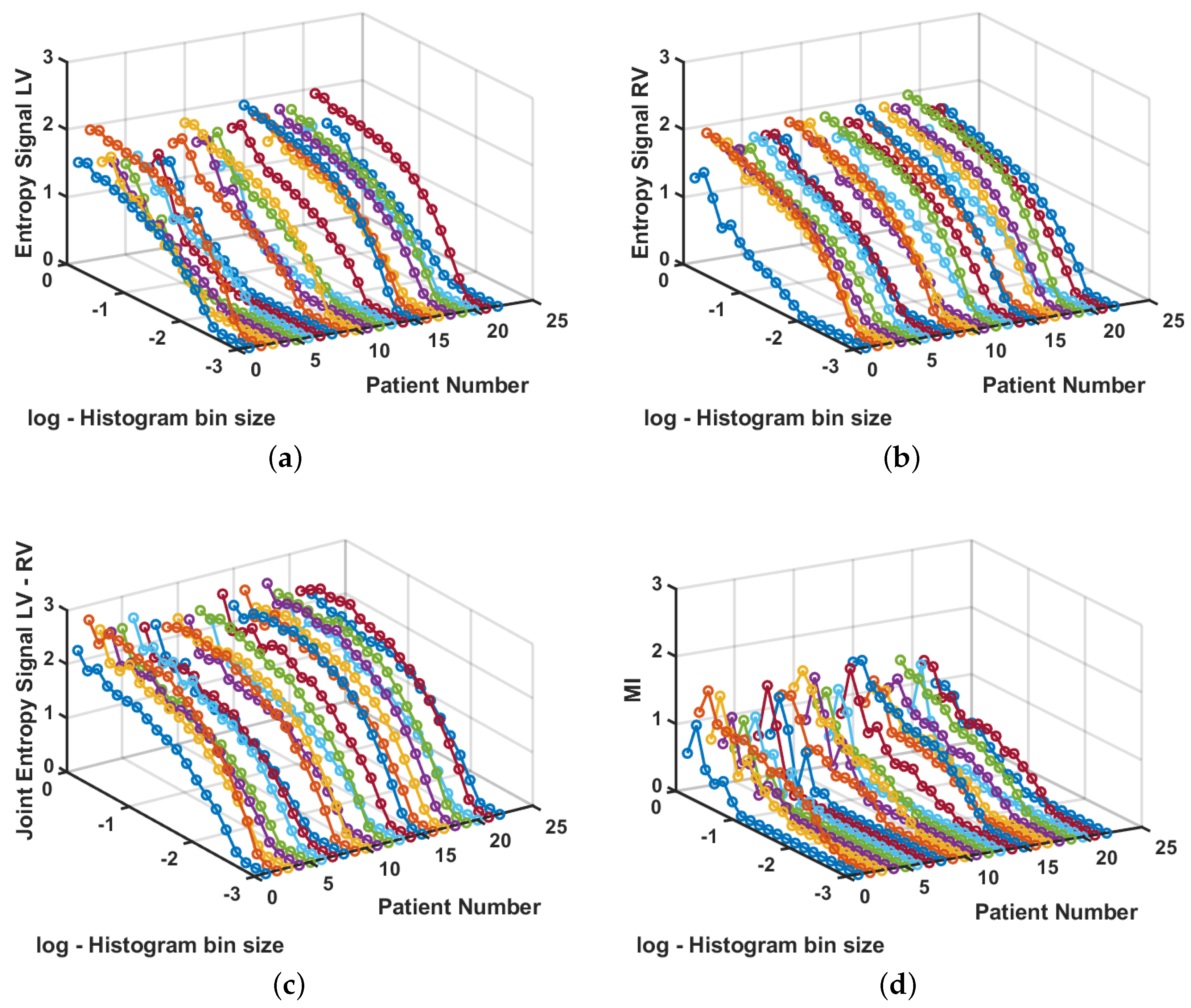
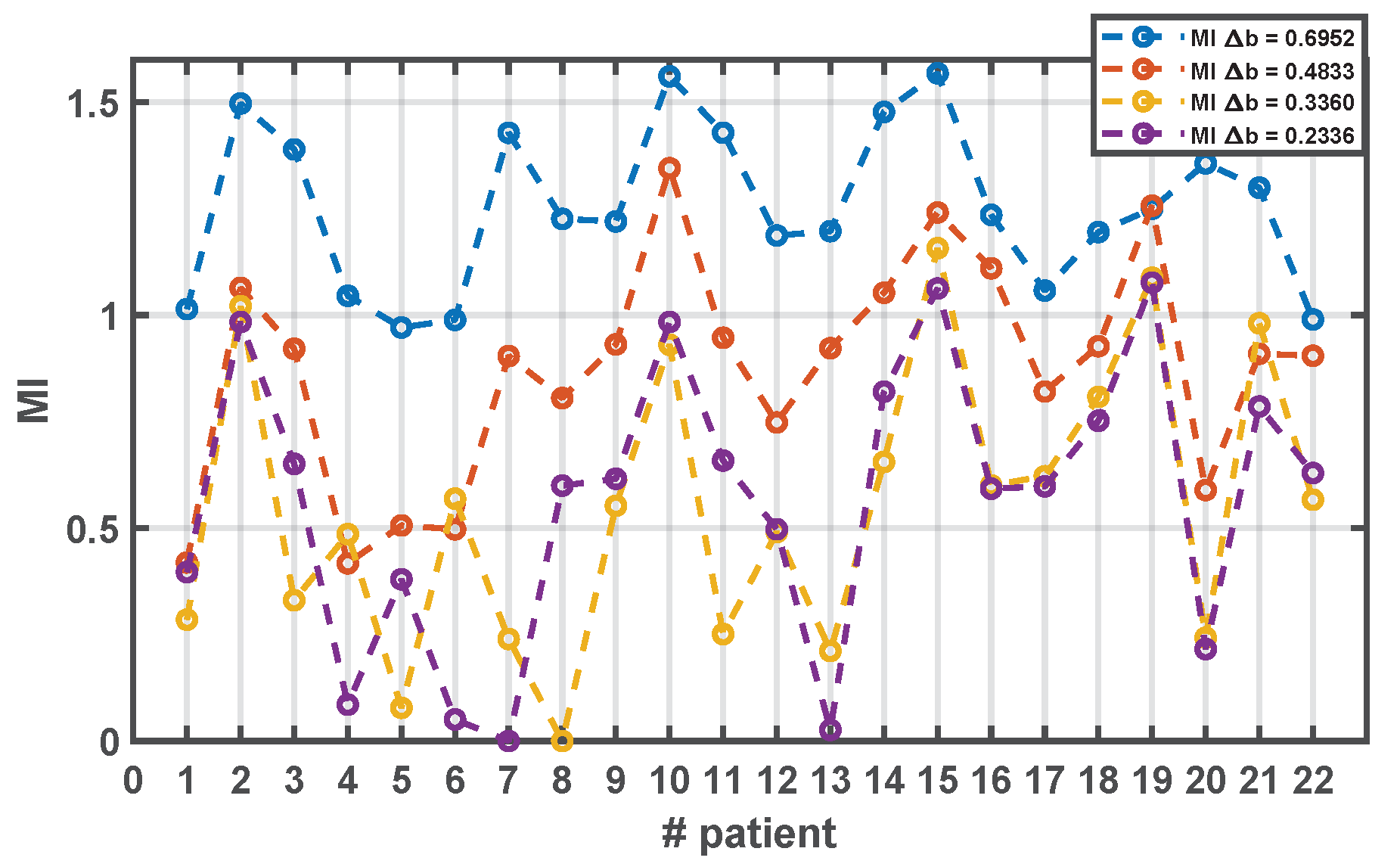
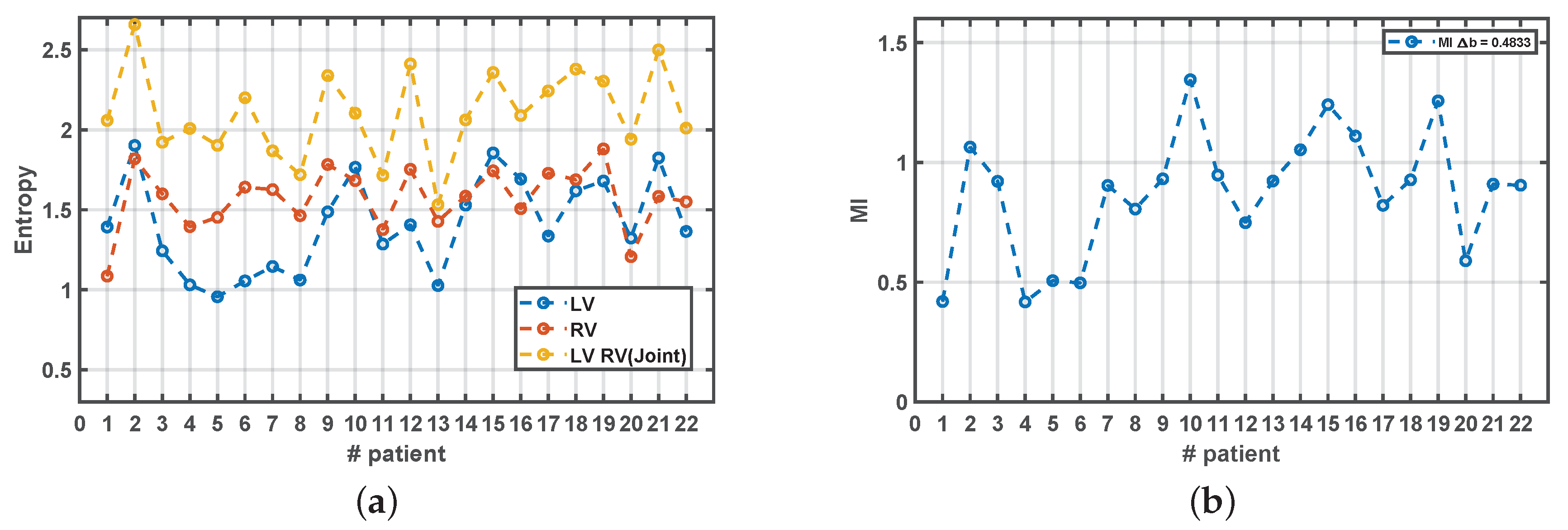
| Parameter | Time Period: 0–3 s | Time Period: 3–6 s | ||||
|---|---|---|---|---|---|---|
| LV | RV | p | LV | RV | p | |
| (Hz) | 4.74 ± 0.62 | 4.74 ± 0.43 | ns | 4.83 ± 0.64 | 4.83 ± 0.47 | ns |
| DF (HZ) | 19.72 ± 4.90 | 15.69 ± 3.37 | 0.004 | 20.45 ± 4.79 | 15.66 ± 4.99 | 0.006 |
| (Hz) | 22.45 ± 4.92 | 22.45 ± 3.70 | <0.001 | 25.97 ± 4.01 | 22.25 ± 3.45 | 0.001 |
| 0.54 ± 0.56 | 0.53 ± 0.66 | ns | 0.62 ± 0.50 | 0.57 ± 0.44 | ns | |
| 5.60 ± 2.62 | 8.27 ± 2.66 | <0.001 | 6.06 ± 2.26 | 7.70 ± 2.69 | 0.022 | |
| 1.95 ± 2.09 | 4.10 ± 2.00 | <0.001 | 2.14 ± 1.98 | 5.01 ± 3.31 | 0.002 | |
| 4.29 ± 3.11 | 7.67 ± 3.09 | 0.002 | 4.42±2.79 | 6.29 ± 3.05 | 0.02 | |
| 4.04 ± 1.61 | 5.78 ± 1.88 | 0.002 | 4.66 ± 1.90 | 5.08 ± 2.06 | ns | |
| 3.39 ± 1.39 | 3.44 ± 1.42 | ns | 4.11 ± 1.61 | 3.66 ± 1.99 | ns | |
| (Hz) | 1.20 ± 0.73 | 1.02 ± 0.39 | ns | 1.27 ± 1.21 | 2.33 ± 5.90 | ns |
| (Hz) | 0.95 ± 0.16 | 0.87 ± 0.11 | ns | 0.93 ± 0.15 | 0.90 ± 0.11 | ns |
| OI | 0.45 ± 0.10 | 0.54 ± 0.11 | 0.003 | 0.48 ± 0.09 | 0.51 ± 0.06 | ns |
| LK | 0.83 ± 0.05 | 0.91 ± 0.04 | <0.001 | 0.85 ± 0.06 | 0.89 ± 0.04 | 0.011 |
© 2020 by the authors. Licensee MDPI, Basel, Switzerland. This article is an open access article distributed under the terms and conditions of the Creative Commons Attribution (CC BY) license (http://creativecommons.org/licenses/by/4.0/).
Share and Cite
Pérez-Gutiérrez, M.F.; Sánchez-Muñoz, J.J.; Erazo-Rodas, M.; Guerrero-Curieses, A.; Everss, E.; Quesada-Dorador, A.; Ruiz-Granell, R.; Ibáñez-Criado, A.; Bellver-Navarro, A.; Rojo-Álvarez, J.L.; et al. Spectral Analysis and Mutual Information Estimation of Left and Right Intracardiac Electrograms during Ventricular Fibrillation. Sensors 2020, 20, 4162. https://doi.org/10.3390/s20154162
Pérez-Gutiérrez MF, Sánchez-Muñoz JJ, Erazo-Rodas M, Guerrero-Curieses A, Everss E, Quesada-Dorador A, Ruiz-Granell R, Ibáñez-Criado A, Bellver-Navarro A, Rojo-Álvarez JL, et al. Spectral Analysis and Mutual Information Estimation of Left and Right Intracardiac Electrograms during Ventricular Fibrillation. Sensors. 2020; 20(15):4162. https://doi.org/10.3390/s20154162
Chicago/Turabian StylePérez-Gutiérrez, Milton Fabricio, Juan José Sánchez-Muñoz, Mayra Erazo-Rodas, Alicia Guerrero-Curieses, Estrella Everss, Aurelio Quesada-Dorador, Ricardo Ruiz-Granell, Alicia Ibáñez-Criado, Alex Bellver-Navarro, José Luis Rojo-Álvarez, and et al. 2020. "Spectral Analysis and Mutual Information Estimation of Left and Right Intracardiac Electrograms during Ventricular Fibrillation" Sensors 20, no. 15: 4162. https://doi.org/10.3390/s20154162
APA StylePérez-Gutiérrez, M. F., Sánchez-Muñoz, J. J., Erazo-Rodas, M., Guerrero-Curieses, A., Everss, E., Quesada-Dorador, A., Ruiz-Granell, R., Ibáñez-Criado, A., Bellver-Navarro, A., Rojo-Álvarez, J. L., & García-Alberola, A. (2020). Spectral Analysis and Mutual Information Estimation of Left and Right Intracardiac Electrograms during Ventricular Fibrillation. Sensors, 20(15), 4162. https://doi.org/10.3390/s20154162







